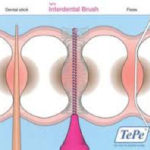Should You Still Floss?
There has been a lot of talk recently that flossing is no longer recommended and I agree, sort of. Read on and I’ll explain what I mean. This issue has come about because of the latest dietary guidelines that had been issued by the Departments of Agriculture and Health and Human Services. They quietly dropped any mention of flossing without notice. The Associated Press then reported that officials had never researched the effectiveness of regular flossing, as required, before “cajoling” Americans to do it. This report then spread like wild fire giving people the excuse not to floss. This report is missing the main point and gives a false sense of security that flossing is not necessary. The main point should have been cleaning in between the teeth is what is important and floss is only one type or modality for cleaning interdentally between the teeth. There are many type of oral hygiene aids that achieve this goal. Let us start with floss then explore the other options, which were left out of the Departments of Agriculture and Health and Human Services report, which are available to clean interdentally.
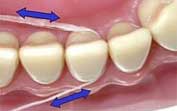 In 1819 Levi Spear Parmly, a dentist from New Orleans, is credited with inventing the first form of dental floss. He recommended running a waxen silk thread “through the interstices of the teeth, between their necks and the arches of the gum, to dislodge that irritating matter which no brush can remove and which is the real source of disease.” It was reported that he considered this the most important part of oral care. Floss was not actually commercially available until 1882. In 1898, the Johnson & Johnson Corporation received the first patent for dental floss that was made from the same silk material used by doctors for silk stitches. To this date, Johnson & Johnson is still producing floss.
In 1819 Levi Spear Parmly, a dentist from New Orleans, is credited with inventing the first form of dental floss. He recommended running a waxen silk thread “through the interstices of the teeth, between their necks and the arches of the gum, to dislodge that irritating matter which no brush can remove and which is the real source of disease.” It was reported that he considered this the most important part of oral care. Floss was not actually commercially available until 1882. In 1898, the Johnson & Johnson Corporation received the first patent for dental floss that was made from the same silk material used by doctors for silk stitches. To this date, Johnson & Johnson is still producing floss.
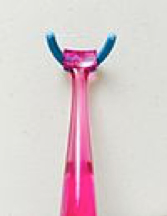
Y-shaped Floss Handle
Floss was the very first interdental hygiene aid and became the standard of care. As with most things as time goes on and knowledge increases better and more effective techniques and devices came about. Handles were incorporated with the floss. In 1935, F.H. Doner invented what today’s consumer knows as the ‘Y’-shaped angled dental appliance.
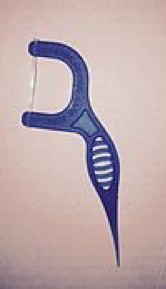
F-shaped Floss Handle
Then in 1963, James B. Kirby invented a tooth-cleaning device that resembles an archaic version of today’s F-shaped floss pick. This shape is very good to get children started in the habit of flossing because the handle is easy to hold and comes in many characters and animals shapes like dinosaurs.
The next major advancement became known as the interdental brush. These brushes look like little pipe cleaners. They have more surface area to clean than floss possesses and hence are more thorough at removing plaque and debris. These brushes also can carry bacterial killing medicates down below the gum and in between the teeth.
The bristles are also able to contact the groove in the root surface of the teeth were floss, while taught, creates a gap by the developmental root groves. The same happens with tooth picks whether made from wood or plastic.
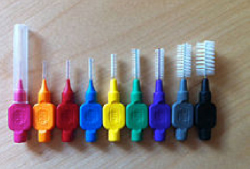
Interdental Brushes
The interdental brushes become indispensable to use as we age. This is because the gums naturally recede as we get older exposing the grooves in the root surface and where plaque and debris can collect. When we’re younger the gum tissue naturally occupies these grooves preventing debris from collecting.
Another classification of interdental hygiene aids are the electric devices such as the Water Pik. These have a reservoir to hold either water or a medicate and pulsates the liquid in between the teeth. These devices are very good for people with advanced gum issues called periodontal disease.
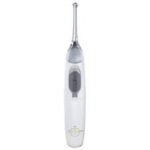
Airflosser
Other electronic devices are the Airflosser which has a liquid reservoir in the handle. This is made by Sonicare and is available in many drug stores.
Another electric flosser is the Power Flosser. It is made by Water Pik but it does not have a liquid reservoir but a snap on the changeable plastic tip that vibrates upon activation. This tip is thin with a rounded end for effective debris removal and is able to reach deep pockets between the tooth and gum.
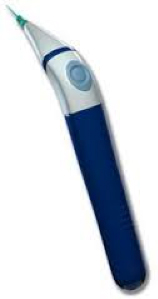
Power Flosser
Due to the many different types of interdental hygiene aids, it can get confusing and you may not know which one is best suited for you. This is where your dental professional can help. Through consistent continuous care, we can help guide you in the proper type and usage of these aids that best suits your dental needs. Your needs will change depending on your age. In general, I recommend my children, adolescents, and young adult patients to use floss. With my middle and elderly age patients, in the absence of gum (periodontal) disease, I help them transition to the interdental brushes. Patients with gum disease, at any age, I recommend the electric interdental hygiene aids with the liquid reservoirs. I hope this article has been informative and helpful and remember as your teeth mature so should your choice of an interdental cleaning aid change as well. So yes I tell a good portion of my patients not to floss! But I do tell them to clean in between.


